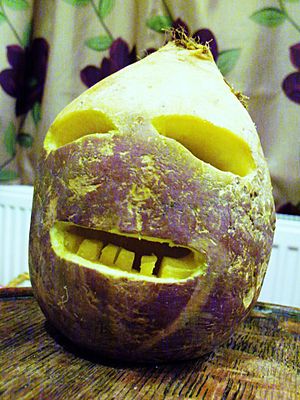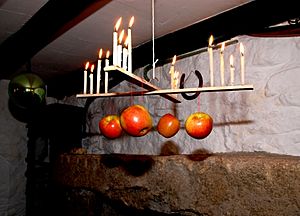Allantide facts for kids
Allantide (also called Kalan Gwav in Cornish, meaning first day of winter), is a special Cornish festival. It's also known as Saint Allan's Day or the Feast of Saint Allan. People traditionally celebrated it on the night of October 31st and all day on November 1st. This festival is part of a bigger celebration known as Allhallowtide in other places.
In Cornwall, Allantide is linked to Saint Allan, who was a bishop in the 500s. Because of him, the festival is sometimes called Allan Night and Allan Day. The name "Allantide" is similar to "Hollantide" in Wales and the Isle of Man, and even to Halloween itself.

Contents
What is Allantide?
Allantide is a traditional festival from Cornwall, England. It marks the start of winter. It's a time for family, good luck, and fun games.
The Meaning of the Name
The Cornish name for Allantide is Kalan Gwav. This means "first day of winter." It's similar to the Welsh name Calan Gaeaf, which also means the first day of winter. This shows how important the change of seasons was to people long ago.
Old Traditions
Just like other parts of Christendom (Christian countries), people in Cornwall would ring church bells during Allantide. This was done to remember and comfort Christian souls.
A very important part of Allantide was giving Allan apples. These were large, shiny red apples that were polished until they gleamed. People gave these apples to their family and friends as a symbol of good luck. Before the festival, special Allan apple markets would open all over West Cornwall where people could buy these special apples.
Allantide in Penzance
Around the early 1800s, people in Penzance celebrated Allantide in interesting ways.
- Shops would show off many polished Allan apples.
- On the day of the festival, everyone in a family would get an Allan apple as a gift for good luck.
- Younger girls would put these apples under their pillows. They hoped to dream about the person they would marry one day.
Fun Games
A popular game during Allantide involved a cross shape made from two pieces of wood.
- Four candles were placed on each arm of the cross.
- Allan apples were hung below the cross.
- The goal was to catch the apples with your mouth.
- If you were too slow or missed, you might get hot wax on you from the candles!
Allantide in St Ives
In St Ives, the tradition of giving children a large apple on Allhallows-eve (October 31st) was very common. This day was known as "Allan-day" and was a big deal for many children. They felt it would be bad luck to go to bed on "Allan-night" without their special Allan apple hidden under their pillow. Selling these apples was so important that it was called the "Allan Market."
Predicting the Future
Some people played games to try and predict what would happen in the future.
- They would throw walnuts into fires to see if their partners would be faithful.
- Another game involved pouring melted lead into cold water. The shape the lead made when it cooled was supposed to show what job a future husband would have.
Tindle Fires
In some parts of Cornwall, people lit "Tindle" fires. These were like the "Coel Coth" fires in Wales. These fires were likely part of the celebrations and traditions of the festival.
St Just in Penwith
Before the 1900s, the local feast day in St Just in Penwith was also known as Allantide. This shows how widespread the festival was in Cornwall.
See also
- Calan Gaeaf - Wales
- Dziady
- Hop-tu-Naa - Isle of Man
- Nickanan Night
- St Allen
- Winter Nights
Images for kids
-
Traditional Cornish jack-o'-lantern made from a turnip






